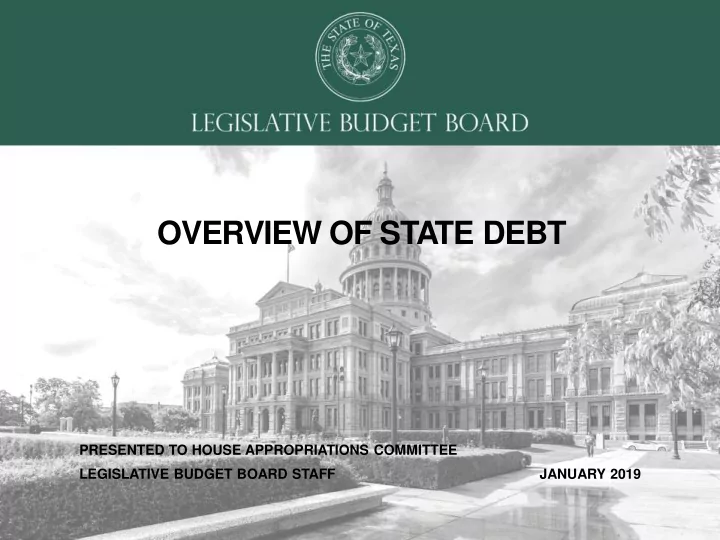

OVERVIEW OF STATE DEBT PRESENTED TO HOUSE APPROPRIATIONS COMMITTEE LEGISLATIVE BUDGET BOARD STAFF JANUARY 2019
Texas State and Local Debt Obligations Total Debt Outstanding = $271.0 billion (as of 8/31/18) State debt $49.1 billion , or 17.3 percent, of total debt outstanding. ● State debt is issued by state agencies and universities and is an obligation of the state. ● Local debt is issued by local governments and is not an obligation of the state. Examples of local debt include construction and renovation of schools, city halls, and county courthouses. ● Conduit debt is debt issued on behalf of third parties and is not a legal liability of the state, such as the Texas Public Finance Authority’s Charter School Finance Corporation, which issues bonds on behalf of charter schools. JANUARY 25, 2019 LEGISLATIVE BUDGET BOARD ID: 5666 2
Overview of Bond Authority State debt includes General Obligation bonds and Revenue bonds: 1. General Obligation (GO) bonds are backed by the full faith and credit of the state. GO bond authority must be approved by two-thirds of both chambers to be placed on a ballot, then approved by a majority of voters. 2. Revenue bonds are authorized by the Legislature, secured by a specific revenue and do not require voter approval. State debt repayment for GO and Revenue bonds can have self-supporting or not self supporting debt service: 1. Self-Supporting debt is expected to be repaid with revenues other than General Revenue, for example loan repayments. 2. Not Self-Supporting debt is expected to be repaid with General Revenue. JANUARY 25, 2019 LEGISLATIVE BUDGET BOARD ID: 5666 3
Summary of Outstanding Debt GENERAL OBLIGATION As of EXAMPLES DEBT 8/31/2018 (in billions) Texas Mobility Fund, Veterans’ Land & Housing Bonds, Self-Supporting $11.7 Certain Water Development Bonds Not Self-Supporting $6.9 Highway Improvement GO Bonds, TPFA Facility GO Bonds Total General Obligation Debt $18.6 Revenue Bond Debt College & University Revenue Bonds, State Highway Self-Supporting $26.5 Fund Not Self-Supporting $0.1 Facility Revenue Bonds & Master Lease Purchase Program Tuition Revenue Bonds* $3.9 Total Revenue Bond Debt $30.5 Total Outstanding Debt $49.1 *Tuition Revenue Bonds (TRBs) are classified as self-supporting debt backed by a pledge of certain revenue funds. The state, however, has historically appropriated General Revenue funds to pay debt service on TRBs. S OURCE : Bond Review Board JANUARY 25, 2019 LEGISLATIVE BUDGET BOARD ID: 5666 4
2020-2021 Debt Service Debt service costs included in the introduced bill for the 2020-21 biennium are approximately $4.2 billion in All Funds. This is a decrease of $60.9 million, or 1.4 percent, from the 2018-19 biennium. METHOD OF FINANCE AMOUNT EXAMPLES (in millions) General Revenue $1,794.2 Tuition Revenue Bonds, TPFA Facility GO and Revenue Bonds, Certain Water Development Bonds General Revenue- $12.9 Cancer Prevention and Research Institute GO Dedicated Bonds Federal Funds $121.8 Texas Mobility Fund, State Highway Fund, Highway Improvement GO Bonds, Certain TPFA Facility GO Bonds Other Funds $2,284.1 Texas Mobility Fund, State Highway Fund, Highway Improvement GO Bonds, Certain Water Development Bonds Total $4,213.0 JANUARY 25, 2019 LEGISLATIVE BUDGET BOARD ID: 5666 5
Constitutional Debt Limit Article III, Section 49(j) of the Texas Constitution limits the authorization of additional state debt if in any fiscal year the resulting annual debt service payable from unrestricted General Revenue (GR) (not self-supporting debt), excluding constitutionally dedicated revenues, exceeds 5.0 percent of the average annual unrestricted GR for the previous three years. FISCAL YEAR FISCAL YEAR 2017 2018 .92% .87% Outstanding Debt Outstanding and Authorized but Unissued Debt 1.43% 1.33% To monitor where the state stands in relation to the constitutional debt limit, the Bond Review Board calculates two debt ratios. The first ratio is the debt service on outstanding or issued debt as a percentage of unrestricted General Revenue Funds. The second ratio is the debt service on outstanding debt plus estimated debt service for authorized but unissued bonds. JANUARY 25, 2019 LEGISLATIVE BUDGET BOARD ID: 5666 6
Bond Issuance Steps STEP 1: The legislature authorizes an amount of bond authority for an agency or purpose. For general obligation bonds, voters must approve a constitutional amendment authorizing the debt. Example: In 2007, the 80 th Legislature authorized and voters approved $1.0 billion for capital • projects, i.e. “Prop 4 Bonds.” STEP 2: The legislature appropriates all, or a portion, of the bond authority to agencies in the form of bond proceeds from the issuance of the debt. It often takes multiple years for the entire bond authority amount to be appropriated, resulting in “authorized but unissued” debt. • Example: The bond proceeds from the Prop 4 bonds were appropriated to multiple agencies over four biennia, from the 80 th to the 83 rd Legislatures. STEP 3: The issuance agency, such as Texas Public Finance Authority (TPFA), issues debt as requested by the agency that is appropriated the bond proceeds to match their expenditure schedule, also resulting in “authorized but unissued” debt. • Example: All bond proceeds from Prop 4 have been appropriated for certain projects, however due to project timelines there is approximately $43.9 million in appropriated but unissued bonds. STEP 4: The legislature appropriates debt service payments to the debt-issuing agency to pay for the principal and interest on the issued, or expected to be issued, bonds – for most state issuances, debt service is paid over 20 or 30 year terms. • Example: Although the Prop 4 bond proceeds were appropriated to multiple agencies, the appropriations for debt service payments are made to TPFA and are reflected as Bond Debt Service Payments at the end of certain Articles in the General Appropriations Act. JANUARY 25, 2019 LEGISLATIVE BUDGET BOARD ID: 5666 7
Contact the LBB Legislative Budget Board www.lbb.state.tx.us 512.463.1200 JANUARY 25, 2019 LEGISLATIVE BUDGET BOARD ID: 5666 8
Recommend
More recommend